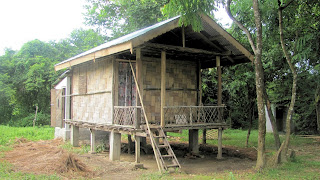Its not any day that one begins in a
crowded city like Bangalore and sleeps the night in Arunachal
Pradesh! And its even rarer to sleep the same night in a wildlife
sanctuary in Arunachal Pradesh! One day in September, I reached Guwahati by
11 in the morning after a two and a half hour flight and then
travelled on a four-wheeler to Tezpur, then on to Seijosa to finally
reach the Pakke Jungle camp at about 10 pm. This camp is run
by Help Tourism and the local Ghora Aabhe Society, and is supported
by the Forest Department and the Nature Conservation Foundation. I
stayed in a modest bamboo house on stilts and slipped into a restful
sleep with the lullaby-hum of a river closeby.
The morning in Pakke began with the
familiar calls of the hyperactive Great Barbets. The cicadas too were
already calling tirelessly and the swifts were collecting their
breakfast from a mid-air buffet. It had rained all night and the
morning seem to begin only lazily, but finally at about 7 am the sun
did pierce through the clouds. With all this happening, the feeling
that I was indeed in Arunachal was still only slowly seeping in.
Aparajita Datta was travelling to the
Pakke Wildlife Sanctuary for a meeting of the Hornbill Nest Adoption
Programme and I had accompanied her. The programme, initiated in
January 2012, aims to protect hornbill nests around Pakke by forming
a unique collaboration between the Nature Conservation Foundation,
Nyishi tribal headsmen from villages around the Pakke Wildlife
Sanctuary who identify and protect nests, the State Forest Department
and urban citizens who fund the programme. In the meeting, a summary
of the 2012-13 programme success was provided, the next years
activities were discussed and the nest protectors were gifted
t-shirts with a Great Hornbill embroidery. It was heartening to see
that the local Nyishi protectors were also taking lot of interest in
the initiative. Below they all got together for a group photo. The first photo was a serious one and then the old man in the bottom right wearing the hornbill t-shirt said something funny and everybody laughed!
In the evening it was time to see the hornbills! We visited the Kameng river and were treated to a view of twin rainbows with the sanctuary in the background.
The other side of the river was beautiful too, it was a collage of clouds.
Just before sunset one can catch a glimpse of Wreathed Hornbills flying to their roost sites for the night. While we waited there for about 45 minutes we saw more than 15 hornbills, some in pairs and some in groups of three or more crossing the Kameng river to reach their roost sites.
Interestingly the hornbills roost in the night at the edge of the
sanctuary where deforestation is relatively high and where they are
also vulnerable to hunting by the locals. But for now, it seemed like
the hornbills were safe due to the efforts of the Forest Department
spearheaded by the Divisional Forest Officer Tana Tapi. Mr. Tana Tapi
has been awarded several awards such as the Carl Zeiss Wildlife
Conservation Award 2010, the Earth Hero Award, 2010 and the WWF-Bagh
Mitra award, 2011 for his efforts in Pakke. The day ended with an
acute sense of hope for the hornbills in Pakke owing to the
relentless efforts of the likes of Tana Tapi, Aparajita Datta and
others at Pakke.








1 comment:
It was a mesmerizing article. I could almost imagine being there and enjoying river's view. I am not sure if its your writing or my fascination with North-east, I couldn't stop reading and wished there were more to it.
Needless to say, it was nice and smooth and really interesting.
Post a Comment